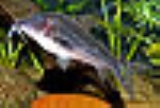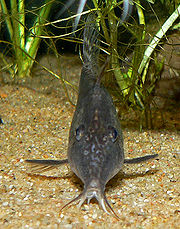
Corydoras semiaquilus
Encyclopedia
Also called South American Armoured Catfish.
Corydoras semiaquilus is a tropical freshwater
fish
belonging to the Corydoradinae sub-family of the Callichthyidae
family. It originates in inland waters in South America
, and is found in the western Amazon River
basin in Brazil
and Peru
. It was originally described by S.H. Weitzman in 1964.
 The fish will grow in length up to 2.4 inches (6.0 centimeters). It lives in a tropical climate in water with a 6.0 - 8.0 pH
The fish will grow in length up to 2.4 inches (6.0 centimeters). It lives in a tropical climate in water with a 6.0 - 8.0 pH
, a water hardness of 2 - 25 dGH
, and a temperature range of 72 - 79 °F (22 - 26 °C). It feeds on worm
s, benthic crustacean
s, insect
s, and plant
matter. It lays eggs in dense vegetation; adults do not guard the eggs.
Corydoras semiaquilus is a tropical freshwater
Freshwater
Fresh water is naturally occurring water on the Earth's surface in ice sheets, ice caps, glaciers, bogs, ponds, lakes, rivers and streams, and underground as groundwater in aquifers and underground streams. Fresh water is generally characterized by having low concentrations of dissolved salts and...
fish
Fish
Fish are a paraphyletic group of organisms that consist of all gill-bearing aquatic vertebrate animals that lack limbs with digits. Included in this definition are the living hagfish, lampreys, and cartilaginous and bony fish, as well as various extinct related groups...
belonging to the Corydoradinae sub-family of the Callichthyidae
Callichthyidae
Callichthyidae is a family of catfishes , called armored catfishes due to the two rows of bony plates running down the length of the body. This family contains some of the most popular freshwater aquarium fish, such as the Corydoras.-Taxonomy:The family derives its name from the Greek words kallis...
family. It originates in inland waters in South America
South America
South America is a continent situated in the Western Hemisphere, mostly in the Southern Hemisphere, with a relatively small portion in the Northern Hemisphere. The continent is also considered a subcontinent of the Americas. It is bordered on the west by the Pacific Ocean and on the north and east...
, and is found in the western Amazon River
Amazon River
The Amazon of South America is the second longest river in the world and by far the largest by waterflow with an average discharge greater than the next seven largest rivers combined...
basin in Brazil
Brazil
Brazil , officially the Federative Republic of Brazil , is the largest country in South America. It is the world's fifth largest country, both by geographical area and by population with over 192 million people...
and Peru
Peru
Peru , officially the Republic of Peru , is a country in western South America. It is bordered on the north by Ecuador and Colombia, on the east by Brazil, on the southeast by Bolivia, on the south by Chile, and on the west by the Pacific Ocean....
. It was originally described by S.H. Weitzman in 1964.

PH
In chemistry, pH is a measure of the acidity or basicity of an aqueous solution. Pure water is said to be neutral, with a pH close to 7.0 at . Solutions with a pH less than 7 are said to be acidic and solutions with a pH greater than 7 are basic or alkaline...
, a water hardness of 2 - 25 dGH
DGH
Degrees of general hardness is a unit of water hardness, specifically of general hardness.General hardness is a measure of the concentration of metal divalent ions such as calcium and magnesium per volume of water...
, and a temperature range of 72 - 79 °F (22 - 26 °C). It feeds on worm
Worm
The term worm refers to an obsolete taxon used by Carolus Linnaeus and Jean-Baptiste Lamarck for all non-arthropod invertebrate animals, and stems from the Old English word wyrm. Currently it is used to describe many different distantly-related animals that typically have a long cylindrical...
s, benthic crustacean
Crustacean
Crustaceans form a very large group of arthropods, usually treated as a subphylum, which includes such familiar animals as crabs, lobsters, crayfish, shrimp, krill and barnacles. The 50,000 described species range in size from Stygotantulus stocki at , to the Japanese spider crab with a leg span...
s, insect
Insect
Insects are a class of living creatures within the arthropods that have a chitinous exoskeleton, a three-part body , three pairs of jointed legs, compound eyes, and two antennae...
s, and plant
Plant
Plants are living organisms belonging to the kingdom Plantae. Precise definitions of the kingdom vary, but as the term is used here, plants include familiar organisms such as trees, flowers, herbs, bushes, grasses, vines, ferns, mosses, and green algae. The group is also called green plants or...
matter. It lays eggs in dense vegetation; adults do not guard the eggs.

